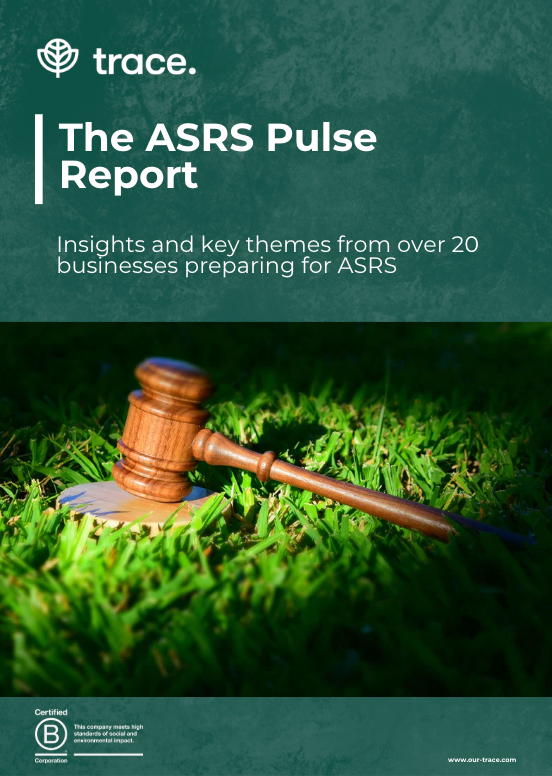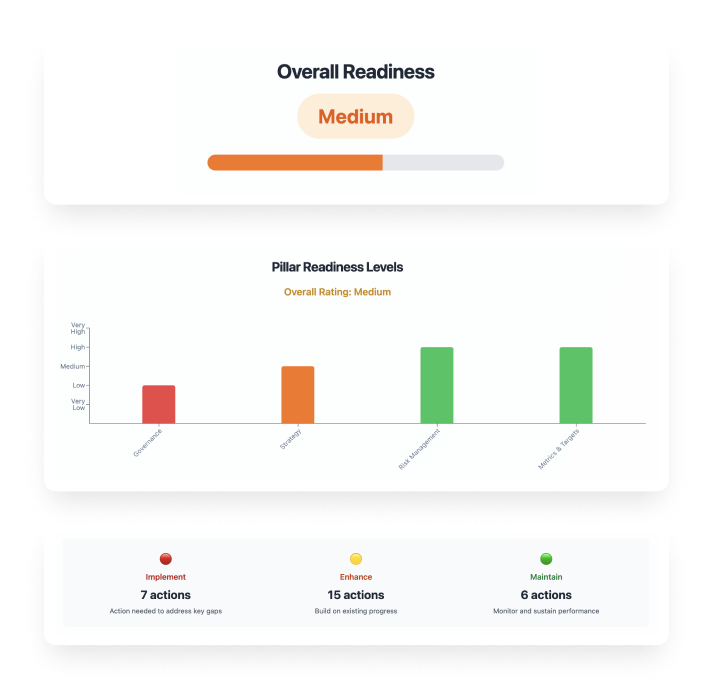Climate risk assessments are systematic processes to identify and evaluate the risks climate change poses to an organisation’s operations, assets, and future prospects. They have become increasingly important as companies face pressure from regulators, investors, and stakeholders to disclose their climate-related risks and resilience plans. In regions like Australia, Europe and the UK, new sustainability reporting standards (e.g. the AU ASRS S2, EU’s CSRD/ESRS and the UK’s SRS aligned with IFRS S2) require businesses to report both physical and transition climate risks that could impact enterprise value.
A robust climate risk assessment not only supports compliance with these frameworks, but also helps organisations stay resilient in a changing climate by clarifying vulnerabilities and guiding strategic action. Beyond compliance, understanding climate risks is vital for long-term business strategy. Severe weather events, supply chain disruptions, carbon pricing, and shifting market preferences are already affecting companies’ financial performance.
By conducting a climate risk assessment, a business can pinpoint which climate-related hazards (like floods, heatwaves, droughts) or transition factors (like new regulations or market shifts) pose the greatest threats to its operationsBy conducting a climate risk assessment, a business can pinpoint which climate-related hazards (like floods, heatwaves, droughts) or transition factors (like new regulations or market shifts) pose the greatest threats to its operations
The assessment results inform risk management decisions – for example, whether to fortify facilities against floods or to diversify supply chains – and ensure the company is proactively building adaptive capacity. In short, climate risk assessments translate the abstract challenge of climate change into concrete risks and opportunities for the organisation, providing a foundation for resilience planning.
The Traditional Climate Risk Assessment Process
Traditionally, climate risk assessments have been delivered by specialist consultants through a structured but manual, resource-heavy process. While thorough, it often takes months and significant internal effort. Below are the typical stages - now mapped to the same six-step framework Trace uses today for simplicity and consistency.
The process starts with defining the scope and objectives of the assessment.
Consultants meet with senior stakeholders to understand why the business is conducting the assessment — for regulatory compliance, investor disclosure, or internal strategy.
This phase also clarifies:
🔹 In Trace’s model, this scoping conversation happens once - in a single context-setting meeting - rather than multiple workshops.
Next, consultants gather data from across the organisation and external sources.
This often includes:
Using this information, the consultant identifies climate hazards relevant to those assets and locations. GIS mapping tools and hazard overlays are used to visualise potential exposure to extreme weather, drought, or sea-level rise.
The analysis is then tied to climate scenarios (e.g., 1.5°C, 2°C, 3°C) to understand how risks evolve under different futures.
⚙️ At Trace, this step is largely automated. Our platform ingests and structures your uploaded data, then maps it against climate hazard datasets instantly - saving weeks of manual analysis with expensive consultants.
With data in hand, consultants identify potential physical and transition risks.
Typical examples include:
Each risk is described in qualitative and quantitative terms — how it manifests, which parts of the business it affects, and the time horizon.
Consultants then draft an initial long list of risks, which can include dozens of entries before prioritisation begins.
💡 Trace’s system optimises this step by scanning your inputs and sector data to generate a draft list of risks aligned with IFRS S2 categories - expert reviews and additional analysis ensure nothing material is missed.
This is a critical stage in determining which risks truly matter for disclosure and decision-making.
Consultants assess each identified risk’s:
These factors are scored or plotted on a risk matrix, producing a clear picture of which risks are high, medium, or low priority.
Materiality under IFRS S2 is defined as any climate risk that could reasonably be expected to affect the entity’s prospects.
The output is a shortlist of material climate risks that warrant management attention and disclosure.
🌱 Trace builds risk assessment into its workflow, applying consistent scoring criteria that ensure transparency and auditability — replacing subjective spreadsheets with structured logic.
Once material risks are defined, the consultant models how they change under different climate scenarios.
This “what if” testing explores:
This step often requires external data or modelling software - and can take weeks of specialist work.
Outputs typically include narrative summaries (“in a high-emissions world, flood risk increases significantly”) and quantitative charts showing projected exposure or losses.
🧠 Trace’s AI engine automates baseline scenario modelling using integrated datasets - letting your experts focus on interpreting results, not building models from scratch.
Finally, consultants compile the findings into a climate risk report - often hundreds of pages long.
This document includes:
While comprehensive, these reports can be static and quickly outdated. They’re difficult to update, audit, or integrate into ongoing risk management.
🚀 Trace generates a draft report in days, structured for IFRS S2 compliance, and fully editable by your internal team. One document upload away from action.
Overall, the traditional consultant-led process is rigorous but time-consuming. According to industry guides, even a basic climate risk assessment can take on the order of 4–6 weeks, while a comprehensive analysis for a large organisation might stretch to 6–12 months of work. This timeline reflects the iterative nature of the process – data collection, multiple stakeholder workshops and interviews, detailed analysis, review cycles, and report preparation. It also highlights why traditional assessments tend to be costly; they involve significant expert labor over an extended period.
.png)
Trace can help you at each stage, at your pace, aligned to your goals.
Reach out to talk to one of our friendly team now
While the traditional approach to climate risk assessment is thorough, it comes with several challenges that organisations are increasingly looking to overcome:
Engaging consulting firms for a full climate risk assessment (especially one that meets emerging disclosure standards) can be very expensive. In some cases, companies have been quoted north of $200,000 for comprehensive climate risk reporting support.
These high project fees often stem from the manual, custom nature of the work – consultants must tailor analyses from scratch, and their pricing models may even incentivise complexity (more complexity means more billable hours). For small and mid-sized enterprises, such costs can be prohibitive.
As noted, a full assessment can take months. It requires a lot of internal effort from the company’s side as well – coordinating data requests, participating in workshops, reviewing drafts, etc. Traditional assessments often involve multiple meetings and surveys. For example, consultants might ask the client to fill out extensive questionnaires or spreadsheets detailing every conceivable risk factor. In practice, sending a client a giant spreadsheet with hundreds of potential risks to evaluate is impractical and overwhelming.
This can lead to fatigue and delays, and important details might slip through cracks if the client cannot realistically fill in such granular data. Essentially, the conventional process can be quite disruptive to day-to-day operations due to the continuous need for information and feedback over weeks or months.
Climate risk analysis relies on good data (asset locations, climate projections, financial impacts) – but companies often struggle with data gaps or uncertainties. Consultants may have to make assumptions or use industry benchmarks, which can introduce subjectivity. Moreover, determining what counts as a “material” risk can be subjective. Current guidelines (like IFRS S2) simply state that companies should identify climate-related risks that “could reasonably be expected to affect the entity’s prospects”, leaving a lot of room for judgment. Different consultants might produce slightly different risk lists depending on their expertise.
Without standardisation, there’s a risk that important issues might be missed or conversely that effort is wasted analysing immaterial details. The lack of consistency also makes auditing or assuring these assessments challenging – how do you know if the risk identification was exhaustive? Traditional methods rely heavily on the consultant’s expertise and the client’s institutional knowledge, which can vary widely.
Often the result of a consultant-led assessment is a static report (200 pages +) or spreadsheet. It’s then up to the company to integrate those findings into their strategy or compliance filings. Because the process is largely outsourced, the internal team might not build capability through the experience. This can create a dependency on external consultants every year or every reporting cycle. Additionally, spreadsheets and long reports can be hard to update – if next year’s data changes, one might have to redo significant work. This traditional output format isn’t always the most user-friendly for iterative risk management.
In summary, the consultant-driven approach, while credible, tends to be slow, costly, and sometimes cumbersome for clients. It’s a model that has worked in an era when climate risk assessment was a niche, occasional project. But with climate disclosures becoming annual and mandatory in many jurisdictions, businesses are seeking ways to streamline this process, reduce the burden, and still get high-quality results.
The traditional consulting model for climate risk assessment is thorough, but slow, costly, and difficult to repeat. As climate disclosures become mandatory and annual, organisations need a smarter, more scalable way to understand and report on their climate risks.
That’s where Trace’s approach comes in. We’re reimagining how climate risk assessments are done — combining technology, structured methodology, and human expertise to make the process faster, lighter, and more useful.
Our vision is simple:Turn climate risk from a complex report into an actionable process.
Here’s what that means in practice:
We’re building a future where a credible, decision-useful climate risk assessment can be achieved in days, not months - without sacrificing quality or rigour.
At Trace we are using best practice to push the boundary of Minimal Viable Compliance. Why? To leave more time for the good stuff, action, impact and strategy.



